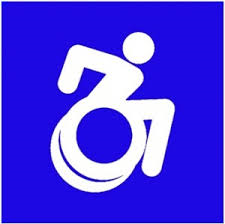July 9, 2013
by: Renee Canfield
Advocates Push to Remove “Handicap” Signs
 A local self-advocacy group for people with developmental disabilities is asking Columbus and Franklin County to officially retire the word handicap whenever new accessibility signs are erected. The advocates want the old description replaced with accessible, the wheelchair symbol or, perhaps even better, a zippy new icon recently adopted in New York City that looks like a wheelchair figure on the move. “With handicap, that sounds like they’re making fun of us,” said Marci Straughter, a member of the Self-Advocate Advisory Council of the Franklin County Board of Developmental Disabilities. “It’s time for a change, and we want to make this happen.”
A local self-advocacy group for people with developmental disabilities is asking Columbus and Franklin County to officially retire the word handicap whenever new accessibility signs are erected. The advocates want the old description replaced with accessible, the wheelchair symbol or, perhaps even better, a zippy new icon recently adopted in New York City that looks like a wheelchair figure on the move. “With handicap, that sounds like they’re making fun of us,” said Marci Straughter, a member of the Self-Advocate Advisory Council of the Franklin County Board of Developmental Disabilities. “It’s time for a change, and we want to make this happen.”
Language is often at the forefront of the self-advocacy movement, which scored a big victory in 2009 when the words mental retardation were dropped from the names of state and county agencies that serve Ohioans with developmental disabilities. “Language does hurt,” said Sadie Hunter, executive director of People First of Ohio. “Taking the word handicap away strengthens people. And it just takes a little bit of effort to make these changes.” Columbus and Franklin County officials say they are willing to make sure that new and replacement signs for parking areas, buildings, bathrooms and other areas do not include the word handicap or handicapped. Advocates say they hope the public stand will prompt private-sector signs to change, too. In a letter sent to the city and county about a week ago, the self-advocate council forwarded resolutions passed in Cincinnati and Hamilton County to eliminate handicapped on public signs. On newer signs and buildings, the changes already have been made, local officials said. But some old signs, such as those posted at the Franklin County Courthouse, 373 S. High St., still use the word handicap.
County Commissioner Marilyn Brown said she’ll push to make the phase-in official. “We have to be welcoming in our language,” said Brown, whose adult daughter uses a wheelchair. “ It seems like a natural for us to just continue as we change signage, to change it to be far more positive and use the contemporary verbiage.” Hunter said some Ohioans want to trade the rigid wheelchair symbol for the active icon developed by the Accessibility Icon Project and make it available on license plates. That icon meets federal standards and has been adopted in cities in New York, Massachusetts, Texas, Canada and western Europe, said Boston-area professor Brian Glenney, project co-founder. “We haven’t gotten any pushback, and we’ve been going for three years,” Glenney said. “It’s a slow phase-in, like how words are being changed. As the words evolve, symbols should evolve as well.”
This article was taken from The Columbus Dispatch, Friday July 5, 2013 By Rita Price, http://www.dispatch.com/content/stories/local/2013/07/05/push-is-on-to-remove-handicap-from-signs.html

Leave a Reply